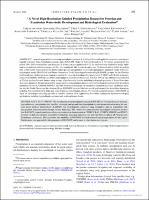Mostrar el registro sencillo del ítem
A Novel High-Resolution Gridded Precipitation Dataset for Peruvian and Ecuadorian Watersheds: Development and Hydrological Evaluation
| dc.contributor.author | Fernández Palomino, Carlos | |
| dc.contributor.author | Hattermann, Fred | |
| dc.contributor.author | Krysanova, Valentina | |
| dc.contributor.author | Lobanova, Anastasia | |
| dc.contributor.author | Vega Jácome, Fiorella | |
| dc.contributor.author | Lavado-Casimiro, W. | |
| dc.contributor.author | Santini, William | |
| dc.contributor.author | Aybar Camacho, Cesar Luis | |
| dc.contributor.author | Bronstert, Axel | |
| dc.date.accessioned | 2022-04-29T14:37:20Z | |
| dc.date.available | 2022-04-29T14:37:20Z | |
| dc.date.issued | 2022-03 | |
| dc.identifier.uri | https://hdl.handle.net/20.500.12542/2006 | |
| dc.description.abstract | A novel approach for estimating precipitation patterns is developed here and applied to generate a new hydrologically corrected daily precipitation dataset, called RAIN4PE (Rain for Peru and Ecuador), at 0.18 spatial resolution for the period 1981–2015 covering Peru and Ecuador. It is based on the application of 1) the random forest method to merge multisource precipitation estimates (gauge, satellite, and reanalysis) with terrain elevation, and 2) observed and modeled streamflow data to first detect biases and second further adjust gridded precipitation by inversely applying the simulated results of the ecohydrological model SWAT (Soil and Water Assessment Tool). Hydrological results using RAIN4PE as input for the Peruvian and Ecuadorian catchments were compared against the ones when feeding other uncorrected (CHIRP and ERA5) and gaugecorrected (CHIRPS, MSWEP, and PISCO) precipitation datasets into the model. For that, SWAT was calibrated and validated at 72 river sections for each dataset using a range of performance metrics, including hydrograph goodness of fit andflow duration curve signatures. Results showed that gauge-corrected precipitation datasets outperformed uncorrected ones for streamflow simulation. However, CHIRPS, MSWEP, and PISCO showed limitations for streamflow simulation in several catchments draining into the Pacific Ocean and the Amazon River. RAIN4PE provided the best overall performance for streamflow simulation, including flow variability (low, high, and peak flows) and water budget closure. The overall good performance of RAIN4PE as input for hydrological modeling provides a valuable criterion of its applicability for robust countrywide hydrometeorological applications, including hydroclimatic extremes such as droughts and floods. © 2022 American Meteorological Society. | es_PE |
| dc.format | application/pdf | es_PE |
| dc.language.iso | spa | es_PE |
| dc.publisher | American Meteorological Society | es_PE |
| dc.relation.uri | https://journals.ametsoc.org/view/journals/hydr/23/3/JHM-D-20-0285.1.xml | es_PE |
| dc.rights | info:eu-repo/semantics/openAccess | es_PE |
| dc.rights | Reconocimiento - No comercial - Sin obra derivada (CC BY-NC-ND) | es_PE |
| dc.rights.uri | https://creativecommons.org/licenses/by-nc-nd/4.0/ | es_PE |
| dc.source | Repositorio Institucional - SENAMHI | es_PE |
| dc.source | Servicio Nacional de Meteorología e Hidrología del Perú | es_PE |
| dc.subject | Precipitación | es_PE |
| dc.subject | South America | es_PE |
| dc.subject | Amazon Region | es_PE |
| dc.subject | Mountain Meteorology | es_PE |
| dc.title | A Novel High-Resolution Gridded Precipitation Dataset for Peruvian and Ecuadorian Watersheds: Development and Hydrological Evaluation | es_PE |
| dc.type | info:eu-repo/semantics/article | es_PE |
| dc.identifier.doi | https://doi.org/10.1175/JHM-D-20-0285.1 | |
| dc.identifier.journal | Journal of Hydrometeorology | es_PE |
| dc.subject.ocde | https://purl.org/pe-repo/ocde/ford#1.05.11 | es_PE |
| dc.subject.sinia | precipitacion - Clima y Eventos Naturales | es_PE |
| dc.type.sinia | text/publicacion cientifica | es_PE |
| dc.identifier.url | https://hdl.handle.net/20.500.12542/2006 | |
| dc.identifier.url | https://hdl.handle.net/20.500.12542/2006 |
Ficheros en el ítem
Este ítem aparece en la(s) siguiente(s) colección(es)
-
Artículo científico [177]









